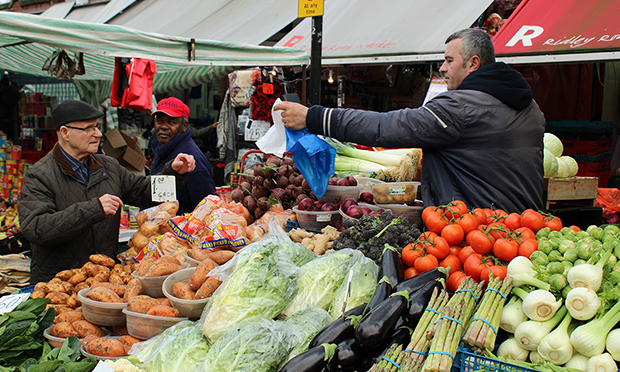‘Later potater!’ The uncommon history of the common spud

Potatoes on display with other vegetables at Ridley Road market
If, crazed with hunger and exhaustion, our weary Roman legionary, on his way back to Londinium from the rigours of duty on Hadrian’s Wall, stumbled forward into another time warp, he would be puzzled by the displays of strange exotic root vegetables in the shops on Kingsland Road or Ridley Road Market.
“Quam nominantur hanc radices?” or “What do you call those roots?” would have provoked answers that puzzle me as much as him. “We call them sweet potatoes, but some folks say yams… no, that’s manioc, that’s taro…”
Some of the uncertainties around the history of our common potato are because the tuber had different names different parts of South America. So when explorers and naturalists described what they found, the names they used were confusing, both to them and to us.
Our spuds (Solanum tuberosum) were known as papas or batatas, but so were sweet potatoes (Ipomoea batatas) and the yam (Dioscorea opposita) was another, while taro (Colocasia esculenta) was yet another root, and cassava (Manihot utilissima) was also called yucca and manioc. Our legionary might have lapped up the Latin, but stayed hungry and confused all the same. And we go on being confused.
Infinite variety (of spuds)
There are many varieties of sweet potato, they come in different shapes and sizes and colours and flavours, from different parts of the world, and can be bought all over Hackney.
The sweet potato was probably discovered in the West Indies long before Columbus arrived in Peru, where it originated thousands of years ago and was known in Europe quite early on. This is not much help to your by now totally muddled historian.
A breath of fresh air, and a trip to the shops is called for. There is a modest butchers and food store in Stoke Newington Church Street, with about seven or eight different roots and tubers displayed outside among the usual fruit and veg.
Inside there’s a roar of good-humoured banter and chatter from cheerful customers, watchful of quality, quantity and cost, as they swoop and peck and dive among the produce. So different from the silent, self absorbed food shopping of the local hipsters in another store, who are probably rigid with grief at not getting a table at The Good Egg.
The dignity and kindness of these ladies, as they answer my naive questions, is heart-warming. “How should I cook this?”
“At home in Jamaica we peel it and boil it.”
“And then…?”
“Well, it’s cooked… you could mash it with butter…” And much more.
Down Ridley Road
Ridley Road Market in the brilliant sunshine of early Saturday morning had an exotic almost tropical appearance, somewhat marred by the intense cold.
Bowls of bright fruit and vegetables glowed and sparkled, and I spotted a bunch of fresh green callaloo. There was time for stall holders and kind ladies to explain more about the produce.
When I get home and peel and boil my modest sweet potatoes, yams, and green bananas it’s a revelation. Mashed with lots of butter with plenty of black pepper and some salt, the flavour and texture are amazing. And it’s the same with all the other sweet potatoes I try.
But I couldn’t stop there, enjoying them with Ackee and Saltfish, the Jamaican national dish, one of the most delicious recipes I’ve ever cooked, or to accompany a dish of callaloo and salt cod.
Simply boiled and mashed, with maybe butter, milk or cream, spiced up with a little finely-chopped Scotch bonnet chilli, some spring onions, black pepper, then covered with more butter and baked in the oven to brown the top.
Most of the different roots and tubers make a meal on their own or an accompaniment to a roast or barbecue, acting as a catalyst to other flavours, comfort food at its most sublime.
The tasty crunch of farofa, toasted coarse manioc flour, strewn over the Brazilian feijoada is a reminder of the versatility of the cassava root, which also gives us tapioca, and memories of truly horrible childhood puddings. Pity about the cyanide. This root, unless treated properly and cooked carefully, can be toxic.
Cutting up most sweet potatoes and other roots is arduous, unlike our soft spuds. A machete might come in handy, as slaves labouring on the plantations must have found. Cooking the local produce and the plants brought with them from West Africa (including okra, ackee, several kinds of yam, peanuts and black-eyed peas), kept slaves well fed and strong, enhancing their cash value.
It is uncomfortable to enjoy our local produce now, while tracing back their origins in the horrible realities of the slave trade and Hackney’s involvement in both its growth and its abolition.
The rural villages within easy reach of the City of London were ideal for the salubrious dwellings of merchants and traders who got rich on the notorious sugar/slave commerce. But the same environment was congenial for the Dissenters and radicals who fought for its abolition.
